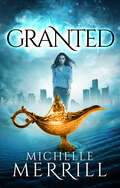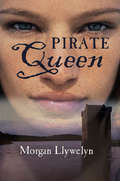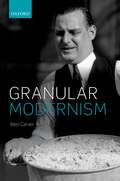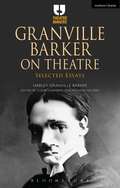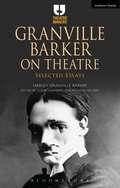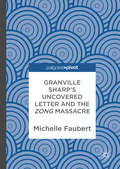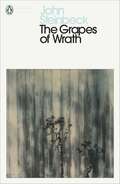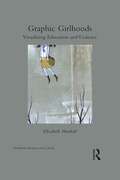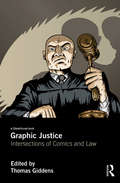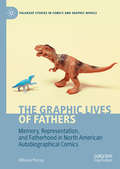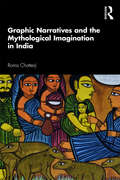- Table View
- List View
Grant Allen: Literature and Cultural Politics at the Fin de Siècle
by Terence RodgersA strikingly interdisciplinary figure in Victorian literary history, Grant Allen (1848-1899) has thus far managed to elude the focused scrutiny of contemporary scholarship. This collection offers a valuable analytical and bibliographical resource for the exploration of the man and his work. Grant Allen was a prolific novelist, essayist, and man of letters, who is best remembered today for his The Woman Who Did (1895), which gained fame and notoriety almost overnight through its exploration of female independence and sexuality outside marriage, precipitating rabid denunciations of the ’new woman.’ Allen engaged with a span of literary and cultural concerns in the late-Victorian period that extended beyond gender politics, however; equally important was his sustained intervention in debates about Darwinism, Spencerism, and evolution, on which subjects he was recognized as an authority and as the foremost popularizer alongside T. H. Huxley and Benjamin Kidd. Not only did Allen’s work link the literary and the scientific, it traversed the boundaries between elite and popular culture, demonstrating their interconnectedness. This was notable in his travel and environmental writings and in his experiments in orientalist and detective fiction, fantasy, and science fiction. The contributors to this collection approach the figure of Allen from diverse fields within Victorian studies, showing him to be a late-Victorian innovator but also an example of fin-de-siècle modernity. Grant Allen: Literature and Cultural Politics at the Fin de Siècle revisits the richly variegated profile of one of the most intriguing and significant polymaths of the turn of the century, recognizing his contribution to and influence on the key modernizing debates of the period.
Grant Allen: Literature and Cultural Politics at the Fin de Siècle
by Terence RodgersA strikingly interdisciplinary figure in Victorian literary history, Grant Allen (1848-1899) has thus far managed to elude the focused scrutiny of contemporary scholarship. This collection offers a valuable analytical and bibliographical resource for the exploration of the man and his work. Grant Allen was a prolific novelist, essayist, and man of letters, who is best remembered today for his The Woman Who Did (1895), which gained fame and notoriety almost overnight through its exploration of female independence and sexuality outside marriage, precipitating rabid denunciations of the ’new woman.’ Allen engaged with a span of literary and cultural concerns in the late-Victorian period that extended beyond gender politics, however; equally important was his sustained intervention in debates about Darwinism, Spencerism, and evolution, on which subjects he was recognized as an authority and as the foremost popularizer alongside T. H. Huxley and Benjamin Kidd. Not only did Allen’s work link the literary and the scientific, it traversed the boundaries between elite and popular culture, demonstrating their interconnectedness. This was notable in his travel and environmental writings and in his experiments in orientalist and detective fiction, fantasy, and science fiction. The contributors to this collection approach the figure of Allen from diverse fields within Victorian studies, showing him to be a late-Victorian innovator but also an example of fin-de-siècle modernity. Grant Allen: Literature and Cultural Politics at the Fin de Siècle revisits the richly variegated profile of one of the most intriguing and significant polymaths of the turn of the century, recognizing his contribution to and influence on the key modernizing debates of the period.
A Grant County Collection: Indelible, Faithless and Skin Privilege (Grant County Ser. #Bks. 4-6)
by Karin SlaughterFrom the bestselling author Karin Slaughter, a triple bill of Grant County novels: Indelible, Faithless and Skin Privilege, all in one thrilling ebook file.IndelibleWhen medical examiner Sara Linton and police chief Jeffrey Tolliver take a trip away from the small town of Heartsdale - an escape from all the pressures which complicate their relationship - it should be a straightforward weekend at the beach. But they decide to take a detour via Jeffrey's hometown and things go violently wrong when Jeffrey's best friend Robert shoots dead an intruder who breaks into his house. Jeffrey and Sara are first on the scene and Jeffrey's keen to clear his friend's name, but for Sara things aren't so simple. The sear marks around the bullet-hole don't tally with Robert's story. Robert's wife, Jessie, is incoherent and confused. And when Jeffrey appears to change the crime scene, Sara no longer knows who to trust. Twelve years later, Sara and Jeffrey are caught up in a shockingly brutal attack which threatens to destroy both their lives. But they're not random victims. They've been targeted. And it seems the past is catching up with both of them ...FaithlessThere are many ways to die. But some are more terrifying than others ... A walk in the woods takes a sinister turn for police chief Jeffrey Tolliver and medical examiner Sara Linton when they stumble across the body of a young girl. Incarcerated in the ground, all the initial evidence indicates that she has, quite literally, been scared to death. But as Sara embarks on the autopsy, something even more horrifying comes to light. Something which shocks even Sara. Detective Lena Adams, talented but increasingly troubled, is called in from vacation to help with the investigation - and the trail soon leads to the neighbouring county, an isolated community, and a terrible secret ...Skin PrivilegeLena Adams has spent her life struggling to escape her past. She has only unhappy memories of Reece, the small town which nearly destroyed her. She's made a new life for herself as a police detective in Heartsdale, a hundred miles away - but nothing could prepare her for the violence which explodes when she is forced to return. A vicious murder leaves a young woman incinerated beyond recognition. And Lena is the only suspect.When Heartsdale police chief Jeffrey Tolliver, Lena's boss, receives word that his detective has been arrested, he has no choice but to go to Lena's aid - taking with him his wife, medical examiner Sara Linton. But soon after their arrival, a second victim is found. The town closes ranks. And both Jeffrey and Sara find themselves entangled in a horrifying underground world of bigotry and rage - a violent world which shocks even them. A world which puts their own lives in jeopardy. Only Jeffrey and Sara can free Lena from the web of lies, betrayal and brutality that has trapped her. But can they discover the truth before the killer strikes again?
Grant Speaks
by Ev EhrlichWhether putting Generals Burnside, Hooker, and Robert E. Lee in their place, or listening to foul-mouthed General Sherman, Hiram Ulysses S. 'Useless' Grant offers an amusingly warped perspective on the Civil War.
The Granta Book Of The American Short Story (PDF)
by Richard FordRichard Ford, who is among the finest of American novelists and short-story writers, edits and introduces this volume. First published by Granta Books in 1992, it became the definitive anthology of American short fiction written in the last half of the twentieth century - an 'exemplary choice' in the words of the Washington Post - with stories by writers such as Eudora Welty, John Cheever and Raymond Carver (and forty others) demonstrating how much memorable power can lie in the briefest narration. Along with The New Granta Book of the American Short Story, this book constitutes an important reflection and judgement of recent American writing - as well as the superb pleasure yielded by the stories themselves.
Grantchester Grind: (Porterhouse Blue Series 2) (Porterhouse Blue #2)
by Tom SharpeThough as cunning as ever, the formidable Skullion - previously head porter, now elevated to Master - is showing signs of physical frailty after his stroke. So the tricky business of appointing a new Master must start all over again. Meanwhile the College's monstrous debts refuse to go away, and a sinister American media mogul seems determined to make a television documentary on the premises, destroying part of the chapel in the process. Moreover, the widow of the previous Master is convinced that her husband was murdered, so she plants an agent in the Senior Common Room to dig up an unpleasant truth that everyone else would prefer kept under the carpet. Faced with such continuing crises, the instinct of the true Porterhouse man is to reach for the bottle - or to fall back on the subtle and traditional Cambridge skills of blackmail and kidnap. But will those be enough?
The Grantchester Mysteries: The Grantchester Mysteries (Grantchester #1)
by James Runcie'Charming, clever and warm: perfect comfort food for the soul' Joanne Harris, TelegraphThe complete collection of the beloved Grantchester Mysteries series, inspiration for the hit ITV series starring James NortonThe Road to GrantchesterSidney Chambers and The Shadow of DeathSidney Chambers and The Perils of the NightSidney Chambers and The Problem of EvilSidney Chambers and The Forgiveness of SinsSidney Chambers and The Dangers of TemptationSidney Chambers and The Persistence of Love'Shrewd, compelling and full of insight - James Runcie elevates the genre to impressive new heights' William Boyd
The Grantchester Mysteries: The Grantchester Mysteries (Grantchester #1)
by James RuncieThe complete collection of the beloved Grantchester Mysteries series--the inspiration for the PBS Masterpiece TV Show starring James Norton.After fighting in World War II and hearing the call to the priesthood, Sidney Chambers begins his career as a full-time priest and part-time detective in the English countryside in 1953. Over the course of the two decades and six books that follow, he finds himself investigating all life's mysteries--from robberies and murders to the larger questions of the meaning of life and death and the nature of sin and forgiveness. Entertaining, suspenseful, and deeply humane, these charming mysteries are bound to delight fans new and old.The Road to GrantchesterSidney Chambers and The Shadow of DeathSidney Chambers and The Perils of the NightSidney Chambers and The Problem of EvilSidney Chambers and The Forgiveness of SinsSidney Chambers and The Dangers of TemptationSidney Chambers and The Persistence of Love
Granted
by Michelle MerrillMichelle Merrill&’s Granted imagines a world where genies like Brielle live secretly among humans. Merrill packs adventure, mystery, romance, and friendship into this coming-of-age young adult fantasy tale.
Granuaile: Pirate Queen
by Morgan LlywelynIn the sixteenth century, Granuaile, the Pirate Queen, warrior and leader, was the terror of the North Atlantic and the most feared woman in Ireland. Heading a large army and a fleet of ships, she lived by trading and raiding and demanding tribute from all who sailed through her territory. Told partly through letters written to her son Tibbot, it charts the gradual decline of the Gaelic chieftains and traditions of Ireland as Elizabeth Tudor, the 'Virgin Queen' of England, extended her power throughout Ireland by bribery and slaughter. It is a story of immense bravery and daring, as Granuaile takes on the great Norman lords, smuggles weapons and mercenaries for the Ulster Gaelic O'Donnell and O'Neill clans and finally goes to confront Elizabeth Tudor herself. Some of the great figures of Irish history feature, including Red Hugh O'Donnell, Hugh O'Neill, Hugh Dubh O'Donnell, and Richard Bingham.
Granular Modernism
by Beci CarverGranular Modernism understands the way that some Modernist texts put themselves together as a way of pulling themselves apart. In this volume, Beci Carver offers a new way of reading Modernist novels and poems , by drawing attention to the anomalies that make them difficult to summarise or simplify. Carver proposes that rather than trying to find the shapes of narrative or argument in their writing, the 'Granular Modernists' - namely, Joseph Conrad, William Gerhardie, Evelyn Waugh, Henry Green, T.S. Eliot, W.H. Auden, and Samuel Beckett - experiment in certain of their works in finding the shapelessness of a moment in history that increasingly confidently called itself 'modern', which was to call itself shapeless. The project of Modernism in the late nineteenth and the first half of the twentieth century, was to find a story to tell about an era full of beginnings. The project of 'Granular Modernism' was to find a way of turning the inchoateness of the modern moment into art. Granular Modernism takes from the Naturalist movements of the nineteenth and early twentieth century its attentiveness to the process of mundane experiences like eating or waiting. But where Naturalism sets out to offer a complete picture of a way of life, Granular Modernism's eating and waiting fail to amount to anything more; to paraphrase Evelyn Waugh: 'The most they can hope for is a cumulative futility.' Frank Norris once described one of Stephen Crane's narrators as: 'a locust in a grain elevator attempting to empty the silo by carrying off one grain at a time.' Norris is being dismissive. But his image of pointless, meticulous, indefinite manoeuvre potentially defines the ambition of the Granular Modernists.
Granville Barker on Theatre: Selected Essays (Theatre Makers)
by Harley Granville Barker Colin Chambers Richard NelsonGranville Barker on Theatre brings together some of the most important critical theatrical writings of Harley Granville Barker, a major figure of 20th-century British theatre. Known as a pioneer of the National Theatre and Repertory Movement, and remembered mainly for his Prefaces to Shakespeare, from the 1900s to his death in the 1940s Granville Barker commented enthusiastically in newspaper items, introductions to plays, articles, essays, articles, and published lectures on a range of topics: the nature of theatre as an art form and as a social medium, the need for ensemble playing in a repertory system, the relationship between the three chief constituents of theatre – the actor, the playwright and the audience. Granville Barker on Theatre makes available again these writings in which Barker dissects the state of theatre as he saw it, with coruscating critiques of the commercial system, the long run and censorship, the vitality of theatre outside Britain, and what he saw as the welcome renaissance of theatre in non-professional groups liberated from the profit motive. These writings show a master practitioner concerned with, above all, promoting a new type of drama; vital not only for its own sake but for the sake of the health of society at large.
Granville Barker on Theatre: Selected Essays (Theatre Makers)
by Harley Granville Barker Colin Chambers Richard NelsonGranville Barker on Theatre brings together some of the most important critical theatrical writings of Harley Granville Barker, a major figure of 20th-century British theatre. Known as a pioneer of the National Theatre and Repertory Movement, and remembered mainly for his Prefaces to Shakespeare, from the 1900s to his death in the 1940s Granville Barker commented enthusiastically in newspaper items, introductions to plays, articles, essays, articles, and published lectures on a range of topics: the nature of theatre as an art form and as a social medium, the need for ensemble playing in a repertory system, the relationship between the three chief constituents of theatre – the actor, the playwright and the audience. Granville Barker on Theatre makes available again these writings in which Barker dissects the state of theatre as he saw it, with coruscating critiques of the commercial system, the long run and censorship, the vitality of theatre outside Britain, and what he saw as the welcome renaissance of theatre in non-professional groups liberated from the profit motive. These writings show a master practitioner concerned with, above all, promoting a new type of drama; vital not only for its own sake but for the sake of the health of society at large.
Granville Sharp's Uncovered Letter and the Zong Massacre
by Michelle FaubertThis book delineates the discovery of a previously unknown manuscript of a letter from Granville Sharp, the first British abolitionist, to the “Lords Commissioners of the Admiralty.” In the letter, Sharp demands that the Admiralty bring murder charges against the crew of the Zong for forcing 132 enslaved Africans overboard to their deaths. Uncovered by Michelle Faubert at the British Library in 2015, the letter is reproduced here, accompanied by her examination of its provenance and significance for the history of slavery and abolition. As Faubert argues, the British Library manuscript is the only fair copy of Sharp’s letter, and extraordinary evidence of Sharp’s role in the abolition of slavery.
Granville Sharp's Uncovered Letter and the Zong Massacre
by Michelle FaubertThis book delineates the discovery of a previously unknown manuscript of a letter from Granville Sharp, the first British abolitionist, to the “Lords Commissioners of the Admiralty.” In the letter, Sharp demands that the Admiralty bring murder charges against the crew of the Zong for forcing 132 enslaved Africans overboard to their deaths. Uncovered by Michelle Faubert at the British Library in 2015, the letter is reproduced here, accompanied by her examination of its provenance and significance for the history of slavery and abolition. As Faubert argues, the British Library manuscript is the only fair copy of Sharp’s letter, and extraordinary evidence of Sharp’s role in the abolition of slavery.
The Grapes of Wrath (Penguin Modern Classics)
by John Steinbeck Robert DeMottShocking and controversial when it was first published in 1939, Steinbeck's Pulitzer Prize-winning epic remains his undisputed masterpiece.Set against the background of dust bowl Oklahoma and Californian migrant life, it tells of the Joad family, who, like thousands of others, are forced to travel West in search of the promised land. Their story is one of false hopes, thwarted desires and broken dreams, yet out of their suffering Steinbeck created a drama that is intensely human yet majestic in its scale and moral vision; an eloquent tribute to the endurance and dignity of the human spirit.
Graphic Encounters: Comics and the Sponsorship of Multimodal Literacy
by Dale JacobsWith the recent explosion of activity and discussion surrounding comics, it seems timely to examine how we might think about the multiple ways in which comics are read and consumed.Graphic Encounters moves beyond seeing the reading of comics as a debased or simplified word-based literacy. Dale Jacobs argues compellingly that we should consider comics as multimodal texts in which meaning is created through linguistic, visual, audio, gestural, and spatial realms in order to achieve effects and meanings that would not be possible in either a strictly print or strictly visual text. Jacobs advances two key ideas: one, that reading comics involves a complex, multimodal literacy and, two, that by studying how comics are used to sponsor multimodal literacy, we can engage more deeply with the ways students encounter and use these and other multimodal texts. Looking at the history of how comics have been used (by churches, schools, and libraries among others) will help us, as literacy teachers, best use that knowledge within our curricula, even as we act as sponsors ourselves.
Graphic Encounters: Comics and the Sponsorship of Multimodal Literacy
by Dale JacobsWith the recent explosion of activity and discussion surrounding comics, it seems timely to examine how we might think about the multiple ways in which comics are read and consumed.Graphic Encounters moves beyond seeing the reading of comics as a debased or simplified word-based literacy. Dale Jacobs argues compellingly that we should consider comics as multimodal texts in which meaning is created through linguistic, visual, audio, gestural, and spatial realms in order to achieve effects and meanings that would not be possible in either a strictly print or strictly visual text. Jacobs advances two key ideas: one, that reading comics involves a complex, multimodal literacy and, two, that by studying how comics are used to sponsor multimodal literacy, we can engage more deeply with the ways students encounter and use these and other multimodal texts. Looking at the history of how comics have been used (by churches, schools, and libraries among others) will help us, as literacy teachers, best use that knowledge within our curricula, even as we act as sponsors ourselves.
Graphic Girlhoods: Visualizing Education and Violence
by Elizabeth MarshallDrawing on a dynamic set of "graphic texts of girlhood," Elizabeth Marshall identifies the locations, cultural practices, and representational strategies through which schoolgirls experience real and metaphorical violence. How is the schoolgirl made legible through violence in graphic texts of girlhood? What knowledge about girlhood and violence are under erasure within mainstream images and scripts about the schoolgirl? In what ways has the schoolgirl been pictured in graphic narratives to communicate feminist knowledge, represent trauma, and/or testify about social violence? Graphic Girlhoods focuses on these questions to make visible and ultimately question how sexism, racism and other forms of structural violence inform education and girlhood. From picture books about mean girls The Recess Queen or graphic novels like Jane, The Fox and Me to Ronald Searle's ghastly pupils in the St. Trinian's cartoons to graphic memoirs about schooling by adult women, such as Ruby Bridges's Through My Eyes and Lynda Barry's One Hundred Demons texts for and about the schoolgirl stake a claim in ongoing debates about gender and education.
Graphic Girlhoods: Visualizing Education and Violence (Children's Literature And Culture Ser.)
by Elizabeth MarshallDrawing on a dynamic set of "graphic texts of girlhood," Elizabeth Marshall identifies the locations, cultural practices, and representational strategies through which schoolgirls experience real and metaphorical violence. How is the schoolgirl made legible through violence in graphic texts of girlhood? What knowledge about girlhood and violence are under erasure within mainstream images and scripts about the schoolgirl? In what ways has the schoolgirl been pictured in graphic narratives to communicate feminist knowledge, represent trauma, and/or testify about social violence? Graphic Girlhoods focuses on these questions to make visible and ultimately question how sexism, racism and other forms of structural violence inform education and girlhood. From picture books about mean girls The Recess Queen or graphic novels like Jane, The Fox and Me to Ronald Searle's ghastly pupils in the St. Trinian's cartoons to graphic memoirs about schooling by adult women, such as Ruby Bridges's Through My Eyes and Lynda Barry's One Hundred Demons texts for and about the schoolgirl stake a claim in ongoing debates about gender and education.
Graphic Justice: Intersections of Comics and Law
by Thomas GiddensThe intersections of law and contemporary culture are vital for comprehending the meaning and significance of law in today’s world. Far from being unsophisticated mass entertainment, comics and graphic fiction both imbue our contemporary culture, and are themselves imbued, with the concerns of law and justice. Accordingly, and spanning a wide variety of approaches and topics from an international array of contributors, Graphic Justice draws comics and graphic fiction into the range of critical resources available to the academic study of law. The first book to do this, Graphic Justice broadens our understanding of law and justice as part of our human world—a world that is inhabited not simply by legal concepts and institutions alone, but also by narratives, stories, fantasies, images, and other cultural articulations of human meaning. Engaging with key legal issues (including copyright, education, legal ethics, biomedical regulation, and legal personhood) and exploring critical issues in criminal justice and perspectives on international rights, law and justice—all through engagement with comics and graphic fiction—the collection showcases the vast breadth of potential that the medium holds. Graphic Justice will be of interest to academics and postgraduate students in: cultural legal studies; law and the image; law, narrative and literature; law and popular culture; cultural criminology; as well as cultural and comics studies more generally.
Graphic Justice: Intersections of Comics and Law
by Thomas GiddensThe intersections of law and contemporary culture are vital for comprehending the meaning and significance of law in today’s world. Far from being unsophisticated mass entertainment, comics and graphic fiction both imbue our contemporary culture, and are themselves imbued, with the concerns of law and justice. Accordingly, and spanning a wide variety of approaches and topics from an international array of contributors, Graphic Justice draws comics and graphic fiction into the range of critical resources available to the academic study of law. The first book to do this, Graphic Justice broadens our understanding of law and justice as part of our human world—a world that is inhabited not simply by legal concepts and institutions alone, but also by narratives, stories, fantasies, images, and other cultural articulations of human meaning. Engaging with key legal issues (including copyright, education, legal ethics, biomedical regulation, and legal personhood) and exploring critical issues in criminal justice and perspectives on international rights, law and justice—all through engagement with comics and graphic fiction—the collection showcases the vast breadth of potential that the medium holds. Graphic Justice will be of interest to academics and postgraduate students in: cultural legal studies; law and the image; law, narrative and literature; law and popular culture; cultural criminology; as well as cultural and comics studies more generally.
The Graphic Lives of Fathers: Memory, Representation, and Fatherhood in North American Autobiographical Comics (Palgrave Studies in Comics and Graphic Novels)
by Mihaela PrecupThis book explores the representation of fatherhood in contemporary North American autobiographical comics that depict paternal conduct from the post-war period up to the present. It offers equal space to autobiographical comics penned by daughters who represent their fathers’ complicated and often disappointing behavior, and to works by male cartoonists who depict and usually celebrate their own experiences as fathers. This book asks questions about how the desire to forgive or be forgiven can compromise the authors’ ethics or dictate style, considers the ownership of life stories whose subjects cannot or do not agree to be represented, and investigates the pervasive and complicated effects of dominant masculinities. By close reading these cartoonists’ complex strategies of (self-)representation, this volume also places photography and archival work alongside the problematic legacy of self-deprecation carried on from underground comics, and shows how the vocabulary of graphic narration can work with other media and at the intersection of various genres and modes to produce a valuable scrutiny of contemporary norms of fatherhood.
Graphic Narratives and the Mythological Imagination in India
by Roma ChatterjiThis book explores graphic narratives and comics in India and demonstrates how these forms serve as sites on which myths are enacted and recast. It uses the case studies of a comics version of the Mahabharata War, a folk artist’s rendition of a comic book story, and a commercial project to re-imagine two of India’s most famous epics – the Ramayana and the Mahabharata – as science fiction and superhero tales. It discusses comic books and self-published graphic novels; bardic performance aided with painted scrolls and commercial superhero comics; myths, folklore, and science fiction; and different pictorial styles and genres of graphic narration and storytelling. It also examines the actual process of the creation of comics besides discussions with artists on the tools and location of the comics medium as well as the method and impact of translation and crossover genres in such narratives. With its clear, lucid style and rich illustrations, the book will be useful to scholars and researchers of sociology, anthropology, visual culture and media, and South Asian studies, as well as those working on art history, religion, popular culture, graphic novels, art and design, folk culture, literature, and performing arts.
Graphic Narratives and the Mythological Imagination in India
by Roma ChatterjiThis book explores graphic narratives and comics in India and demonstrates how these forms serve as sites on which myths are enacted and recast. It uses the case studies of a comics version of the Mahabharata War, a folk artist’s rendition of a comic book story, and a commercial project to re-imagine two of India’s most famous epics – the Ramayana and the Mahabharata – as science fiction and superhero tales. It discusses comic books and self-published graphic novels; bardic performance aided with painted scrolls and commercial superhero comics; myths, folklore, and science fiction; and different pictorial styles and genres of graphic narration and storytelling. It also examines the actual process of the creation of comics besides discussions with artists on the tools and location of the comics medium as well as the method and impact of translation and crossover genres in such narratives. With its clear, lucid style and rich illustrations, the book will be useful to scholars and researchers of sociology, anthropology, visual culture and media, and South Asian studies, as well as those working on art history, religion, popular culture, graphic novels, art and design, folk culture, literature, and performing arts.







